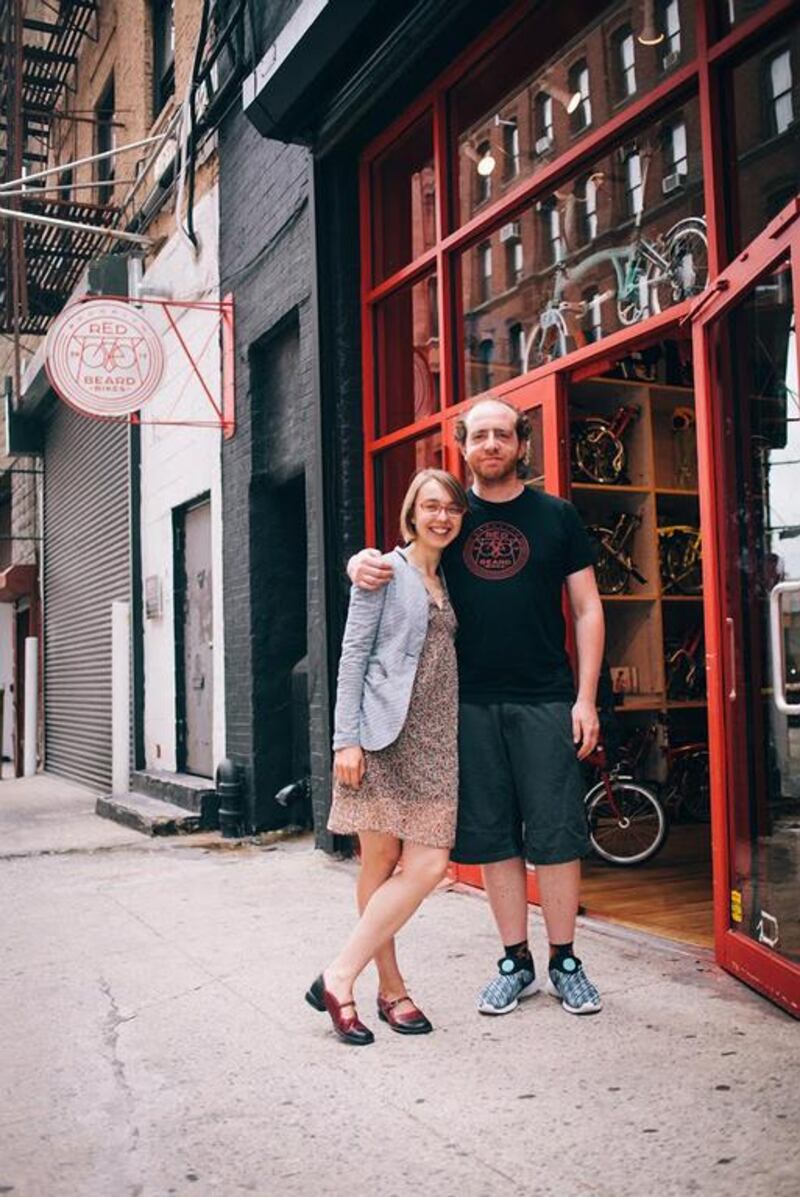NEW YORK // When Kasia Nikhamina began commuting between Queens and Manhattan on her bicycle 11 years ago, it seemed to her like all of New York City’s notoriously short-tempered motorists were outraged to see a rare cyclist daring to share the roads with them.
“Back then it was pretty scary, drivers would yell at me,” said Ms Nikhamina, 30, an avid cyclist and the owner of Red Beard Bikes, which builds custom-made bicycles and sells bikes and gear for beginners.
“Once someone spat at me out of their window. People would curse and yell, ‘get on the pavement!’ Do I look like a threat? No, I was just on a bike.”
Fortunately for Ms Nikhamina – and the tens of thousands of other New Yorkers who now cycle to work or for pleasure – much of America’s largest city has been transformed over the past decade.
Today, it is a model for how to successfully integrate cyclists and decrease demand on taxis and overburdened public transport. The focus in the past 10 years has been to reduce accidents and increase profits for businesses through new infrastructure.
“I used to commute to school [on bicycle from Brooklyn to Manhattan] in 2001 and I’d usually be the only person on the Brooklyn Bridge,” said Ilya Nikhamin, Ms Nikhamina’s husband, also 30. “Now if you go during rush hour there’s bike traffic, there’s a long line to get to the bridge.”
Many of the changes that have allowed for the increasing use of cycles were controversial and unpopular at their inception, but now seem like they have always been part of the city’s landscape.
The nearly 650 kilometres of bike lanes across Manhattan and parts of Brooklyn may have been the product of former New York mayor Michael Bloomberg and his crusading transportation commissioner, but without advocates like the Nikhamins, the political pressure that paved the way for changes would have been unlikely.
Last week, under the shadow of the Manhattan Bridge in Brooklyn, the couple sat in a hip cafe a few storefronts from Red Beard Bikes, discussing how the city’s infrastructure has brought change to its cycling culture.
In 2007, Ms Nikhamina joined a volunteer committee in Brooklyn with Transportation Alternatives, the largest bike advocacy group in New York. The group, and others like it, assessed what could be done at key locations to facilitate commuting by bicycle, and sent the recommendations to the city’s department of transportation.
At that time, this type of grassroots advocacy for cycling was just gaining momentum, but the ferment showed city officials there was a demand for such changes. It also emboldened the newly appointed transportation commissioner, Janette Sadik-Khan, herself a bike advocate, who began experimenting on a small scale with temporary infrastructure changes such as car-free pedestrian and cycling zones, and protected cycle lanes.
That process led to the roll-out in 2008 of a plan by then mayor Mr Bloomberg to transform the city’s streets. Cars and lorries were no longer the primary focus. Pedestrians and bicyclists were to be given equal billing.
Residents in some areas protested at the changes, but the stark results silenced them. Injuries and fatalities dropped for both bicyclists and pedestrians, while more people chose cycling – a fast and less expensive means of transport, and businesses benefited from the extra non-car traffic.
"Fundamentally, we flip the transportation hierarchy on its head. Instead of cars being at the top, it's people at the top," Ms Sadik-Khan told Bicycling Magazine last month when discussing the changes she put in place. "That's a very different lens to look at transportation through."
Between 2007 and 2014, the number of daily bicycle commuters in New York jumped from just over 26,000 to around 40,000, thousands more using a mix of cycles and public transport. The current mayor aims to have 6 per cent of New Yorkers commuting on bicycles by 2020, compared with just 1.2 per cent currently.
“We showed that streets that are safer are better for businesses, and when you have those kinds of numbers, it’s a very different conversation,” Ms Sadik-Khan said. Now, eight years later, “a lot of our work is kind of the status quo”, she said.
The launch of the CitiBike programme in May 2013 also contributed to the New York’s bicycle revolution. Citigroup funded a bike-share programme with 6,000 cycles available at docking stations around Manhattan and Brooklyn. Before the launch, there were many naysayers but since then, CitiBikes have become ubiquitous, with everyone from tourists to high schoolers to bankers in suits riding the blue bikes around the city.
CitiBike has plans to expand the programme farther into Brooklyn and also to Queens, doubling the number of bikes available by the end of 2017. As of December 8 last year, the programme had clocked up nearly 25 million rides, and 158,000 annual members in addition to the thousands of casual riders, according to city data.
Despite these changes, there are still roadblocks for cycling proponents to overcome. Even with the average risk of serious injury or death falling 75 per cent by 2013, according to the transportation department, some say the police are not strict about enforcing traffic laws when it comes to accidents between cycles and cars. And although the speed limit has been lowered to 40 kph from about 50 kph, riders say police often side with drivers and treat cyclists with disdain.
In October, a photo posted on Twitter of police officers painting over bike lanes so that cars could illegally park in them sparked outrage among riders.
Still, Mr Nikhamin is hopeful that that cyclists will soon be accepted as a normal feature of New York’s streets.
“CitiBike riders will teach the city how to respond to bikes and the infrastructure will follow the use, and as the infrastructure grows the use will grow and it’s going to be a constant cycle,” he said, sipping his coffee which he bartered for bike services with the cafe’s employees.
tkhan@thenational.ae





